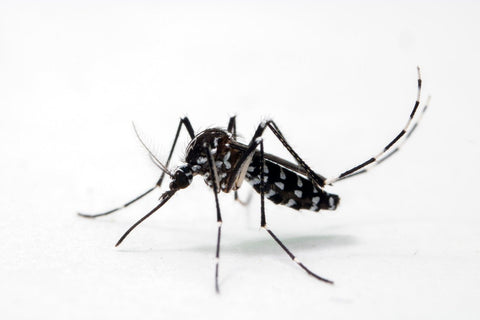The tiger mosquito (Aedes albopictus) and the yellow fever mosquito (Aedes aegypti) are two invasive mosquito species known worldwide for their role in transmitting dangerous diseases. Both species originally come from tropical and subtropical regions but have spread to temperate zones due to global trade and climate change.
Controlling these mosquitoes is of great importance to prevent the spread of diseases such as dengue fever, Zika virus, and yellow fever. This article explains why it makes sense to repel these mosquito species naturally with the VapoWesp fumigation box.
The tiger mosquito: A threat to health
The tiger mosquito is a striking insect that is easily recognizable by its black and white stripes on its legs and body. Originally native to Southeast Asia, the tiger mosquito has spread to many parts of the world in recent decades, including Europe and North America. This mosquito is known for its aggressiveness and its ability to transmit numerous diseases.
It is especially problematic that the tiger mosquito is active during the day, which makes protection against bites more difficult. Therefore, controlling this mosquito is of great importance to protect public health.
The yellow fever mosquito: A dangerous disease carrier
The yellow fever mosquito is another member of the Aedes genus and originates from Africa. It has also spread worldwide through human activities and is now found in many tropical and subtropical regions. The yellow fever mosquito is particularly notorious for its role in transmitting yellow fever, a potentially fatal disease that can cause severe liver and kidney damage.
In addition to yellow fever, the yellow fever mosquito is also a carrier of dengue fever, the Zika virus, and the chikungunya virus. Like the tiger mosquito, the yellow fever mosquito is active during the day and prefers to bite near human dwellings.
This makes them a particularly annoying and dangerous pest.
Traditional control methods and their disadvantages
Mosquito control is traditionally carried out using insecticides that contain chemical substances lethal to insects. However, this method has significant drawbacks. On the one hand, insecticides can also be harmful to humans and other animals. They can cause skin irritation, respiratory problems, and other health issues. On the other hand, mosquito populations develop resistance to many of these chemicals over time, reducing their effectiveness.
Another disadvantage is the environmental impact. Insecticides can contaminate soils and water bodies, thereby disrupting the ecological balance. They can kill beneficial insects and reduce biodiversity. Therefore, it is important to find alternative methods for mosquito control that are less harmful to humans and the environment.
Take preventive measures:
To prevent the spread of mosquitoes, the following measures can be taken:
-
Avoid standing water accumulations:�
Remove unused containers like buckets or watering cans where rainwater can collect or turn them upside down. -
Cover rain barrels tightly against mosquitoes:�
This prevents mosquitoes from laying eggs in them. -
Clear gutters of leaves several times a year:�
This reduces potential breeding sites for mosquitoes. -
Constant cleaning: Clean saucers of plant pots, drinking troughs, paddling pools, or any surfaces that can fill with water at least once a week. Always dispose of garbage immediately.

The VapoWesp fumigation box: A natural solution
The VapoWesp fumigation box offers a natural and effective method to repel tiger mosquitoes and yellow fever mosquitoes. This innovative solution uses natural ingredients to keep mosquitoes away in an environmentally friendly way.
Since all insects are smoke avoiders, the toxin-free smoke from smoldering coffee grounds also has a repellent effect on yellow fever and tiger mosquitoes without harming humans or pets.
Advantages of natural mosquito repellent
-
Health Safety: The use of natural fumigants like in the VapoWesp fumigation box minimizes the risk of health problems associated with chemical insecticides / biocidal products. The natural ingredients are generally non-toxic to humans and pets.
Insecticides / biocides can cause health damage to humans and animals when inhaled inevitably.
-
Environmentally friendly: Natural fumigation mixtures are biodegradable and leave no harmful residues in the environment. They do not contribute to soil and water pollution and protect beneficial insect populations.
Toxic smoke does not distinguish between beneficial and harmful insects and thus also harms those we want to protect!
-
Avoidance of resistance: Since natural fumigants work differently than chemical insecticides, the likelihood of mosquito populations developing resistance is lower.
This ensures long-term effectiveness.
All insects have had the instinct to flee from smoke for hundreds of years.
-
Pleasant scent: The VapoPowder herbal mixture, which is burned with the coffee powder in the VapoWesp fumigation box, spreads a pleasant scent that additionally creates a relaxed atmosphere. This is especially beneficial when used in living rooms or on terraces.
The control of the tiger mosquito and the yellow fever mosquito is of great importance to prevent the spread of dangerous diseases. However, traditional chemical insecticides have significant drawbacks regarding health and the environment.
The VapoWesp fumigation box offers a natural and effective alternative that is both safe and environmentally friendly. By using natural ingredients, mosquitoes can be repelled gently without endangering the health of humans and animals. Promoting such eco-friendly solutions is an important step towards sustainable mosquito control.






